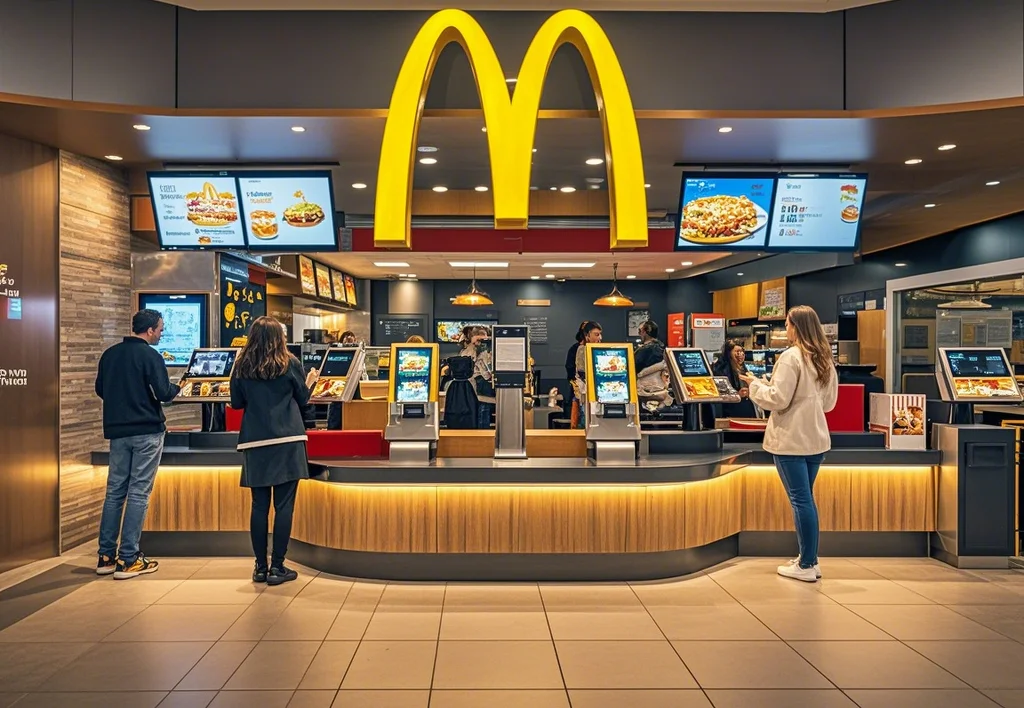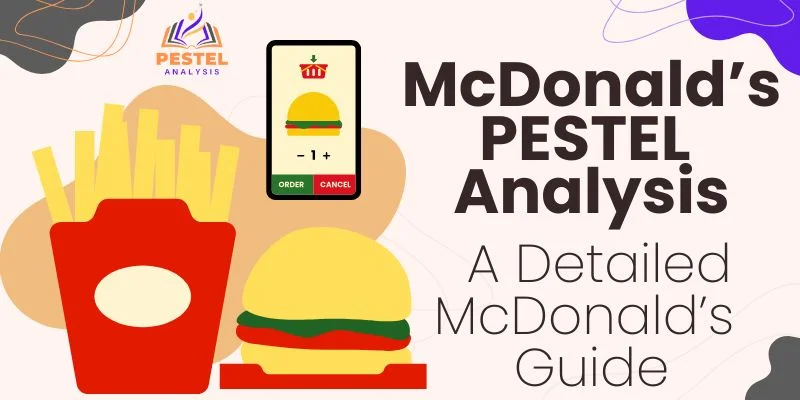This PESTLE analysis (PESTEL analysis) evaluates the strategic challenges facing McDonald’s Corporation in its business environment. Based on the remote or macro-environment of the fast-food business, the PESTEL analysis model helps identify the external factors that present opportunities and threats for strategic management. These factors include political, economic, sociocultural, technological, legal, and ecological (PESTLE) factors.
McDonald’s utilizes strategies to maximize the benefits of industry opportunities in this business analysis. In addition to addressing external factors, these strategies address competing rivalries with fast-food companies, including Wendy’s, Burger King, Subway, and Dunkin’, as well as McCafé competitors, like Starbucks Coffee Company. In order to adapt to changes in the business environment, McDonald’s uses its strengths, such as the trends outlined in this PESTEL analysis, as the world’s largest fast-food restaurant chain.
For the food-service industry to survive and grow in the long run, such adaptation is essential. In addition to aggressive competition, McDonald’s also faces threats outlined in the PESTLE analysis.
Introduction of McDonald
Almost all parts of the world are served by McDonald’s, one of the world’s dominant fast food chains. The company has more than 37,855 outlets in 119 countries (2018). In 2020, they were ranked ninth in global brand value. McDonald’s is one of the world’s largest fast-food chains, but their business can be impacted by a variety of macro factors.

For an objective assessment of their future potential, a PESTEL analysis can be helpful. Knowing the basic information about McDonald’s is essential to a proper PESTEL analysis. An overview of the brand can be found here:
Overview of McDonald’s
| Company Name | McDonald’s Corporation |
| CEO | McDonald’s Corporation |
| Company type | Fast Food restaurant |
| Year founded | 15 May 1940 |
| Number of employees | Approximately 200,000 (in 2021) |
| Annual revenue | US$ 23.24B (in 2022) |
| Founder | Richard and Maurice McDonald Ray Kroc |
| Area Served | Worldwide |
| Headquarters | Chicago, Illinois |
| Operating Income | US$10.356 billion (2021) |
McDonald Pestel Analysis
Fast food chain based in America has a strong brand image and is recognized worldwide. The company serves more than 69 million customers worldwide, making them one of the biggest restaurant chains in the world. Multiple external factors have contributed to McDonald’s current state based on a detailed PESTEL Analysis. A future growth and threat analysis will also be provided.

Factors Affecting McDonald’s Political Business
McDonald’s business is affected by government policies and actions in the macro-environment or remote environment of the company. Governing intervention is considered a determinant of the growth rate and direction of the food-service industry in the PESTLE analysis framework. Fast-food restaurant chain McDonald’s is affected by the following political factors:
International trade can expand McDonald’s Corporation’s multinational business, enhancing global supply chains, thereby enhancing global trade. The PESTEL analysis also identifies the threat and opportunity of stricter governmental diet and health guidelines for restaurant chains. McDonald’s, for instance, has been criticised for the health effects its products have on consumers because of this political factor. The company can however improve its products as a result of this external factor when examined as part of a PESTLE analysis.

It is possible to address this external factor by adjusting McDonald’s generic competitive strategy as well as focusing on product development in a way that is intensive. The restaurant chain business is also facing threats and opportunities as governments evolve public health policies. A common example of the threat posed by this external factor is the reduction in school support for fast food policies and programs.
Consumers still have the opportunity to choose healthier options from the business. In order to address this political factor, McDonalds can add more healthy menu items to its 4P marketing mix. McDonald’s Corporation’s PESTLE analysis shows that despite threats to its business, political factors create significant opportunities.
Factors Affecting McDonald’s Economic Business
The macro-environment of McDonald’s is influenced by economic conditions and trends. Food-service business performance is affected both directly and indirectly by economic changes. McDonald’s industry environment is examined using the PESTLE analysis which takes into account varying levels of influence of local, regional, and global economies, focusing on the following economic factors:
The PESTLE framework predicts McDonald’s will grow and increase its business stability as developed countries are experiencing slow but stable economic growth. Restaurant chain revenues continue to be dominated by the U.S. market, but European markets have also grown steadily. Fast food businesses and their markets are considered a threat by this PESTEL analysis due to the slowdown in the Chinese economy.

McDonald’s revenue comes primarily from the Chinese market, which is a strategic issue. PESTEL analysis points to the company’s potential growth in developing markets, indicating the potential for growth in these high-growth markets. McDonald’s business growth is largely driven by economic factors in this PESTLE analysis.
Factors Affecting McDonald’s Social/Sociocultural Business Environment
McDonald’s business is influenced by social factors in this aspect of the PESTEL analysis. The macro-environment and remote environment of the restaurant company are affected by social trends. McDonald’s Corporation’s PESTLE analysis considers the following sociocultural factors:
This PESTEL analysis indicates that McDonald’s can grow alongside the rise in disposable incomes due to the increasing capacity and tendency of consumers to buy and eat convenient fast food instead of cooking healthier meals at home based on the external factor of rising disposable incomes.

A PESTLE analysis of the restaurant business also considers busy urban lifestyles as a sociocultural factor. Fast-food restaurants, such as McDonald’s, appeal to consumers because of their hectic schedules.
The PESTEL analysis of the food-service industry environment perceives cultural diversity as a threat and an opportunity. It is a challenging business environment for McDonald’s to achieve high levels of customer satisfaction and revenue despite varying preferences among consumers in both local and domestic markets due to increasingly diverse consumer preferences. It is possible that the restaurant chain will collapse if it is unable to address this social factor. However, if it is able to adapt effectively, the chain will be more stable. As a result of the PESTLE analysis, McDonald’s also has the opportunity to achieve optimal consumer satisfaction in regional markets by developing flexible product designs.
McDonald’s, known for its health-damaging products, is at risk from the healthy lifestyle trend. The PESTEL analysis, however, indicates that the company can improve its menu items’ healthfulness.
This aspect of McDonald’s PESTLE analysis presents significant opportunities for growth. Consumers’ perceptions of the fast-food company are influenced by these external factors. A corporate social responsibility (CSR) strategy, ESG initiatives, and stakeholder management initiatives are some strategies McDonald’s uses to counteract the negative effects of social trends on the business, but the company must also develop other strategies to address these external influences.
Factors Affecting McDonald’s Technological Business
PESTEL analyses the remote-environment or macro-environment of McDonald’s business to determine how technologies and trends may impact it. A restaurant chain’s success depends on adapting to technological trends and maximizing their available resources in this case of external analysis. McDonald’s technology factors considered in this PESTLE analysis are:
For McDonald’s to achieve greater business effectiveness and efficiency, it should increase its R&D investments. In this PESTLE analysis, an objective is to increase restaurant chain competitiveness through increased R&D activity. PESTEL analysis also identifies the opportunity for the company to implement more automation in order to maximize its productivity. Adding such automation may require McDonald’s to change its productivity and operations management approaches.

Additionally, this PESTLE analysis indicates that fast-food businesses may be able to reach more consumers through mobile applications by improving their mobile services. According to technological trends, food sales via mobile devices are increasing, resulting in revenue growth for the company. A major opportunity for McDonald’s food-service division to grow has been identified in the technological aspect of the PESTEL analysis.
Factors Affecting McDonald’s Ecological/Environmental Business
McDonald’s remote or macroenvironment is impacted by trends associated with the natural environment as part of the PESTEL analysis. The purpose of this analysis is to explore how ecological trends affect businesses and consumers, especially in the food and beverage industry. McDonald’s and its business environment were analyzed using the PESTLE framework, which highlights the following ecological factors:
As a result, McDonald’s Corporation can strengthen its brand and business performance by improving its sustainability and environmental programs. The goal of this PESTEL analysis of the restaurant chain business is to identify opportunities associated with corporate environmental programs and sustainable business practices, both of which are increasing in importance. The PESTLE analysis shows that such ecological factors may support McDonald’s business stability and growth.
In contrast, McDonald’s food-service business is viewed as a threat by a PESTEL analysis of climate change in some regions. A company’s supply chain is influenced by climatic conditions, including the availability and stability of food supplies. As a result, McDonald’s must further diversify its supply chain to address the effects of climatic trends as a result of the external factors in this aspect of the PESTLE analysis.
Factors affecting the law
McDonald’s’ impact on laws and regulations is one component of the PESTLE analysis. Restaurant chains are shaped by changes in legal systems and new laws that impose new or modified business requirements. McDonald’s industry environment is influenced by the following legal factors:
Several workplaces and schools have health regulations that restrict the availability and accessibility of fast food. McDonald’s revenues could be reduced in affected market segments because of such a limiting effect, according to this PESTLE analysis. A PESTEL analysis of this restaurant firm classified animal welfare regulations as both a threat and an opportunity. McDonald’s supply chain, for example, is costlier due to these regulations. A comprehensive animal welfare policy can, however, draw more customers interested in animal welfare into the food-service business by implementing the same external factor.
McDonald’s costs and prices are also threatened by the rise of minimum wages, in this PESTLE analysis. It is unavoidable that this legal trend will continue, and fast-food businesses must optimize their efficiencies in order to remain competitive despite rising costs. Accordingly, McDonald’s strategies must address legal threats imposed by this aspect of the PESTEL analysis.
FAQs
A company’s profitability, growth, and operation are affected by economic factors. Those factors relate to social and cultural aspects that may affect consumer preferences, lifestyles, and demographics.
In its attempt to lower costs, McDonald’s has slowed the introduction of new menu items and innovations, which has put it at a disadvantage against its competitors. As a result, sales can decline and market share can be lost. McDonald’s lacks control over costs.
With changing consumer preferences, increased competition, and food delivery services like Uber Eats and DoorDash on the rise, McDonald’s is one of many food companies facing challenging times.
Conclusion
As a result of the PESTEL analysis of McDonald’s, we have been able to examine the macroenvironment of the fast food industry at a global level in great detail.
Therefore, we can identify McDonald’s management’s key strategic opportunities and threats.
If you want to properly understand your business’s macroenvironment, you must complement the Pestel framework with other analyses.
There are many models available to help you analyze your industry’s competitive intensity and degree of attractiveness, including Michael Porter’s Five Forces model and the VRIO model, which explores your company’s resources and capabilities.
You may want to share this article with your friends and family for them to gain a better understanding of McDonald’s Pestel analysis.







